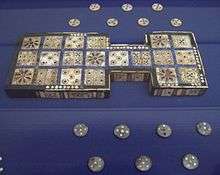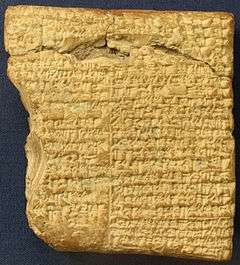Royal Game of Ur
 | |
| Created | 2600–2400 BC |
|---|---|
| Period/culture | Early Dynastic III |
| Registration | 1928,1009.378 |
The Royal Game of Ur, also known as the Game of Twenty Squares, refers to an ancient game represented by two gameboards found in the Royal Tombs of Ur in Iraq by Sir Leonard Woolley in the 1920s. The two boards date from the First Dynasty of Ur, before 2600 BC, thus making the Royal Game of Ur one of the oldest examples of board gaming equipment found, although Senet boards found in Egyptian graves predate it as much as 900 years. The Ur-style Twenty Squares gameboard was also known in Egypt as Asseb, and has been found in Pharaoh Tutankhamen's tomb, among other places. Discovery of a tablet partially describing the gameplay has allowed the game to be played again after over 2000 years, although reconstructions of the detailed rules have differed widely.
One of the two boards from Ur is exhibited in the collections of the British Museum in London.[1]
Gameplay

The Royal Game of Ur was played with two sets, one black and one white, of seven markers and three tetrahedral dice. After around 1000 BC, the layout of the twenty squares was altered to make the end course for the markers a straight line. The rules of the game as it was played in Mesopotamia are not completely known but there have been a number of reconstructions of gameplay, based on a cuneiform tablet of Babylonian origin dating from 177–176 BC by the scribe Itti-Marduk-Balāṭu. It is universally agreed that the Royal Game of Ur, like Senet, is a race game.
Both games may be predecessors to the present-day backgammon.
Graffito boards
A graffito version of the game was discovered on one of the human-headed winged bull gate sentinels from the palace of Sargon II (721–705 BC) in the city of Khorsabad,[1] now in the British Museum in London (see illustration). Similar games have since been discovered on other sculptures in other museums.
In popular culture
- Modern game companies have sold game sets featuring reproductions of the original game board, along with rules derived from the tablet. Among them are Ur: Royal Game of Sumer, from Selchow & Righter in association with the British Museum.
- The television series Lost references the discovery of the game when John Locke explains the origins of backgammon to Walt in the episode "Pilot, Part 2."
- In the film Screamers some of the characters play the game for cigarettes.
- In the "Queen Esther & Purim" episode of The Naked Archaeologist, it is proposed as the game which Haman uses to choose the date to commit genocide against the Jews in captivity.
- In the MMORPG Achaea, Dreams of Divine Lands, Ur is played by the inhabitants of Istarion, under the name Nai-an'tzai-an'har.
- In the action-adventure game Uncharted 3: Drake's Deception, one of the hidden treasures is the board game.
References
- 1 2 "Assyrian guardian figure". BBC. Retrieved 2010-09-10.
Bored guards have scratched a gaming board on the plinth. The game is a version of the 'Game of Twenty Squares', which was played at Ur in southern Iraq in about 2,600 BC.
Further reading
- Becker, A., "The Royal Game of Ur" in Finkel, ed., 2008 pp. 11–15.
- Bell, R. C., Board and Table Games from Many Civilisations Revised edition, two volumes bound as one. New York, Dover Publications, 1979.
- Botermans, Jack, et al., Le monde des Jeux, Paris, Cté Nlle des Editions du Chêne, 1987.
- CHN "Iran's Burnt City Throws up World’s Oldest Backgammon"], Iranian Cultural Heritage News Agency 4/12/2004 (sic: ambiguous date).
- Finkel I., "La tablette des régles du jeu royal d'Ur", Jouer dans l'Antiquité, Catalogue de l'Exposition, Marseille, Musée d'Archéologie Méditerranéenne, 1991.
- Finkel, I., Games: Discover and Play Five Famous Ancient Games, London, British Museum Press, 1995.
- Finkel, I. L., "On the Rules for The Royal Game of Ur" in Finkel, ed., 2008 pp. 16–32.
- Finkel, I. L. ed., Ancient Board Games in Perspective: Papers from the 1990 British Museum colloquium with additional contributions, London, British Museum Press, 2008.
- Lhôte, J.-M., Histoire des jeux de société, Paris, Editions Flammarion, 1994.
External links
- This article is about an item held in the British Museum. The object reference is ME 120834.
- The Royal Game of Ur including history and suggested gameplay
- Royal Game of Ur pages rules history and links
- Time's article on the game
- Android implementation

